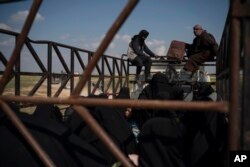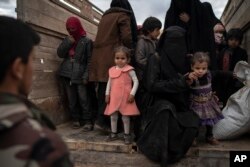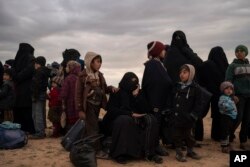Conflicting accounts have emerged regarding the fate of the Islamic State terror group's self-proclaimed caliphate, pitting the word of the president of the United States against that of U.S.-backed forces on the ground in Syria.
President Donald Trump on Thursday appeared to announce the fall of the last sliver of the IS caliphate, a small collection of tents and ruined buildings in the eastern Syrian village of Baghuz.
"We just took over, you know, you kept hearing it was 90 percent, 92 percent, the caliphate in Syria. Now it's 100 percent," he said while visiting with U.S. troops at Joint Base Elmendorf-Richardson in Alaska.
"You saw what happened. Everybody saw. We have the whole thing," he added. "We did that in a much shorter period of time than it was supposed to be."
Rebuke from YPG
But the comments, which barely caused a stir among the troops in attendance, quickly drew a sharp rebuke on Twitter from YPG spokesman Zana Amedi, who berated the president's "ignorance" regarding the battlefront as "abhorrent."
"For weeks, several #SDF officials made it clear that civilians remaining in Daesh-held territory would be protected and their safety would have to be ensured before moving on to the last pocket," Amedi wrote, using the Arabic acronym for the terror group. "Victory doesn't seem to be coming in next days."
And a spokesman for the YPG, a Kurdish militia that forms the majority of the U.S.-backed force, predicted that the fight would not end for at least a week.
The YPG, or People's Protection Units, is a Kurdish militia that makes up a large part of the U.S.-backed Syrian Democratic Forces (SDF).
Fight against IS
Trump's comments also contrasted with a statement made earlier in the day by the lead commander of U.S.-backed forces in Syria, who said it would still be days before a total victory over the caliphate could be assured.
"We will announce the complete victory over Daesh in a week," Commander in Chief Mazloum Kobani said in a video released by SDF officials, citing the continued evacuation of civilians from Baghuz.
Just over a week ago, SDF commanders said there were likely just a thousand or so civilians left in the IS holdout, and admitted the massive outflow since then had taken them by surprise.
U.N. officials on the ground in Syria estimate that in the past week alone, 13,000 civilians from Baghuz have been taken to the nearby al-Hol displaced-persons camp, with 3,500 arriving Thursday alone.
The overwhelming majority are women and children, many of whom are malnourished, according to U.N. officials.
And SDF officials say there are more to come.
"SDF is predicting about a couple of thousands of civilians are still inside and to be evacuated, which is not taking less than one week," Amedi wrote on Twitter.
"Judging by what we're told by people [who] fled, ISIS is not simply laying down arms and surrendering," he added, using an initialism for Islamic State. "Instead, they're preparing to make a last stand, which is making it harder to predict a quick ending."
When contacted for comment Thursday, Pentagon officials referred VOA to the White House, which has yet to comment.
Previous declaration
This would not be the first time Trump, who has repeatedly expressed a desire to pull 2,000 U.S. troops from Syria, has announced the end of IS.
"We have defeated ISIS in Syria, my only reason for being there during the Trump Presidency," he tweeted Dec. 19, 2018, adding in a video released by the White House that "we have beaten them and we have beaten them badly."
And several times this past month, Trump has teased possible announcements about the end of the IS caliphate within days or hours.
But despite being reduced to a small patch of land, IS has held on by using civilians as human shields and by utilizing a series of tunnels and caves underneath Baghuz, which have allowed fighters to hide and to launch occasional counterattacks against SDF forces.
Pace of airstrikes slows
The pace of airstrikes against the group has also slowed, due in part to weather and the presence of so many civilians.
"It is a very difficult and complex situation," coalition spokesman Col. Sean Ryan told VOA this week. "The threat remains as long as Daesh fighters have not given up in Baghuz, and have the will and weapons to fight."
But despite the delays, retired Gen. David Petraeus, a former commander of U.S. forces in Iraq and Afghanistan, praised the SDF's cautious approach.
The SDF is "ensuring that there are not civilian casualties that will really cast a shadow on what should be a very significant achievement," he told VOA Thursday.
Current U.S. defense and intelligence officials have repeatedly warned that even once the IS caliphate is defeated, the terror group will remain a threat.
Officials believe the terror group still has about 13,000 fighters spread across Syria, many operating as part of an active insurgency or sleeper cells.
"The focus will have to shift to what are groups of insurgents and terrorist cells in Iraq and in Syria," Petraeus said. "You see on a daily basis a number of attacks from these residual elements."
In the meantime, the focus will remain on Baghuz, which may still be hiding high-ranking IS officials.
The coalition Thursday confirmed the death of Fabien Clain, also known as the French voice of IS for his work in narrating the group's French propaganda videos, in an airstrike in Baghuz on Feb. 20.
"The coalition continues to target ISIS in its last safe haven in Syria while disrupting ISIS attempts to re-emerge in liberated areas as they plot attacks throughout the region and the West," the coalition said in a statement.



































